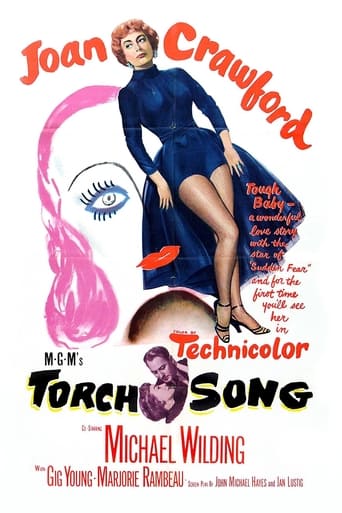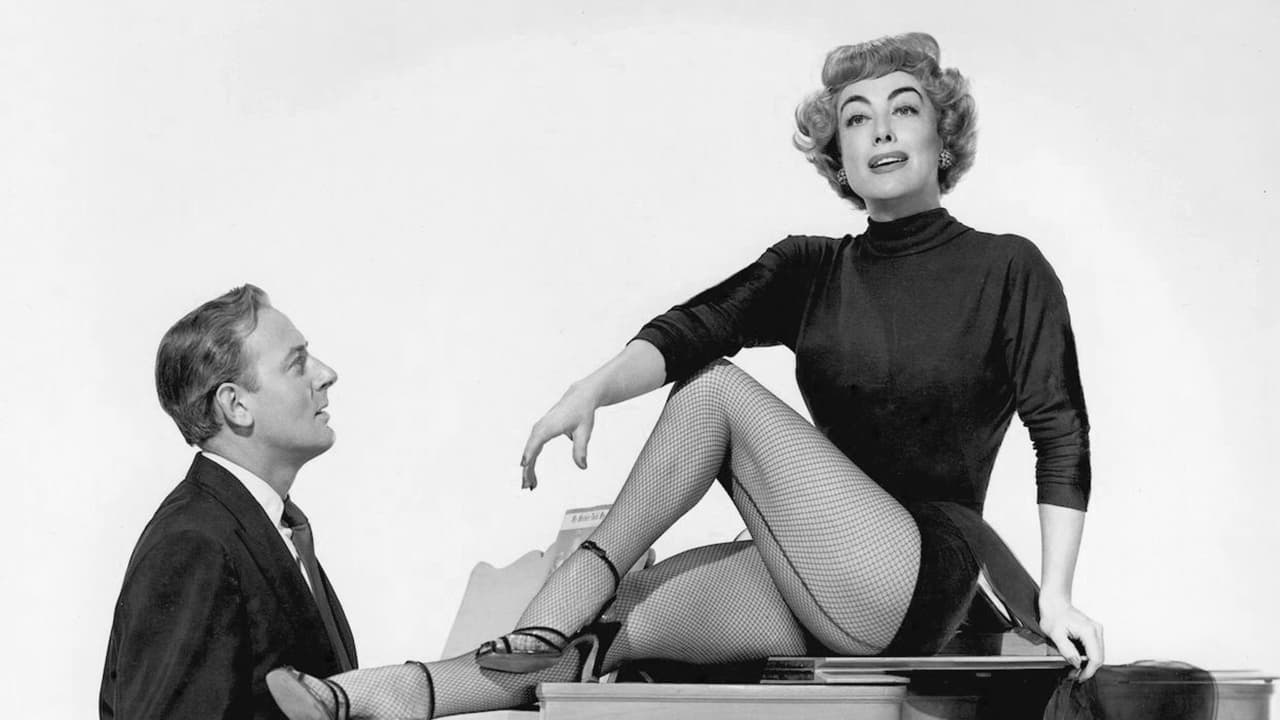Ric-7
Everything in the prior comments on this film-- It's all true, and then some. Rating this film is difficult. It's so bad it is fun. High camp at its extreme. Joan has more poses than a bodybuilder and more faces than a totem pole. The signing is dubbed, the dialog is from outer space, and the plot developments beggar description: The Blind Rehearsal Pianist, Joan in Black Face, . . .As you sit there, watching in amused disbelief, random thoughts occur, such as wondering how this film would have been with Bette Davis. Or imagining Joan in "Hello Dolly!" My rating is based on my enjoyment of the film--it is a hoot. But also an overripe mess. I love it.
adamshl
This may not be the greatest romantic drama with music ever made, but it does have its assets. The main one is that this is almost a one-woman show starring Joan Crawford.The Technicolor is gorgeous, the music tuneful, choreography pleasant and as for the costumes--all that can be said is "wow!" Helen Rose outdid herself in designing Crawford's wardrobe--some two dozen costume changes that are simply stunning. Likewise, the cinematography and set decoration are lush and richly presented.As for the script, it's all Crawford's. Never has she been as irritable, insulting, moody and yet strangely vulnerable. She lip syncs to some pleasant numbers, and does a dance with the director of this movie, Charles Walters. (When did a star ever do a number with her director?) Joan looks very attractive throughout, obviously delighted to be back at MGM after a ten-year hiatus.It's a very campy treat for Crawford fans, to see Joan strut her stuff. Michael Wilding plays his part gracefully and Gig Young is among those on the sidelines. Generally a forgotten film, it's worth a look on a rainy afternoon.
nycruise-1
Second time I've seen it.So many don't things add up I can't imagine this movie wasn't concocted as some sort of payback by some former-flunky-turned-Hollywood-producer out to "get back" at Joan.The color styling is offputting - garish in way unlike any other movie of its time.Joan ends up cast as a variant of her "Harriet Craig" character: controlling, bitchy, chewing every one and everything (like cigarettes) up, then spitting them out. (I guess they should have named the character "JENNY Craig"???)She just comes off looking completely ridiculous.Oh - that blackface number - "Two-Faced Women" - very curious. Referred to as "The Finale" by the show's stage manager, it bears the marks of some awful editing/re-shooting.When they are first scrambling to take places, the chorus looks like they're decked out in coal-black face makeup (the burnt-cork of the old minstrel performers). Then Joan starts the number and looks similar.Strangely, after she makes her way down to the male members of the chorus, she lightens up (on her makeup - NOT her hammy-acting), while they seem to have lost theirs. For the rest of the number, the blackface seems to have disappeared on the guys, lightened up considerably on the girls (I think one female may even be a real African-American), then at the close of the number suddenly everyone darkens down. Finally, when Joan tears off her wig in frustration at Ty's departing despite her "wonderful" rendition of "Two-Faced Woman", she sports not only dark makeup but rhinestones on her eyebrows. The orange hair that sprouts out from under her black wig - disheveled as it is - makes her look like a troll doll from the 1970s (Joan was ahead of her time?). Oddly enough, her "look" seems a color complement to the getup Faye Dunaway put together for "Mommie Dearest":black- vs. white-face, orange vs. dark hair. It is in no way complimentary - it looks absurd, not dramatic, and I'm sure she was completely unhappy when she saw the result on screen (I think even audiences in the 1950s during the first-run of this trainwreck must have laughed at her bizarre appearance.)Someone has also mentioned the "all-male" plus one party thrown by Jenny. Jeez - it's filled with gay entendres - but the strangest aspect of all is the fact that a genuine African- American actor is at the piano, apparently singing but in reality dubbed by professional dub artist Bill Lee.From what I can tell, very little original music was written for this piece - a very curious decision considering MGM had all the song-writing talent they needed.One dance rehearsal uses a Fred Astaire song from "Royal Wedding", in another instance a dropped number intended for Cyd Charisse in "The Bandwagon" (the aforementioned "Two- Faced Woman" blackface) gets a second attempt at life here via Joan (it dies an ignoble death unfortunately).I just can't believe anyone was serious regarding this production - except the actors, in particular poor Joan who was desperate to regain her former crown at her old studio.
moonspinner55
Fruity semi-musical in Technicolor starring Joan Crawford--returning to her old stomping grounds, MGM. Crawford didn't make many pictures in color, and she looks great in this, particularly in dark make-up for the Cotton Club-styled number "Two-Faced Woman" (for the capper, Crawford rips off her black wig, her flaming red hair wild underneath). The plot, taken from I.A.R. Wylie's short story "Why Should I Cry?", is pure hokum: tough-as-nails Broadway star drives everyone to the breaking point, but she meets her match in the new rehearsal pianist, a blind war veteran who has harbored a crush on the performer for many years. The scenes of Crawford's tyrannical Jenny Stewart bossing everyone around are a hoot (it resembles a song-and-dance variation on "Harriet Craig"!). Charles Walters ably directed (and also plays a dancer who, perhaps ironically, is brow-beaten by Joan), although he gets serious acting out of Crawford only once, in the film's final scene. She looks every inch the star, smoking furiously and showing lots o' leg, but her dancing barely passes muster and her vocals were dubbed. Still, not bad, with the compensation being some unintentional comedy (noticing the clock in her bedroom is an hour slow, Crawford angrily corrects the time, and then, as if ready to chew the timepiece out, she gives the clock a smirking once-over). Michael Wilding holds his own as the new man in her life, Gig Young has an obtuse role as Crawford's party pal, and Marjorie Rambeau plays Joan's mother of humble means (and received an Oscar nomination!). Some well-handled scenes, and one has to give points to the star for her courage: what other screen icon (besides Bette Davis, of course) would be so brave as to intentionally come across so steely cold? **1/2 from ****



 AD
AD



